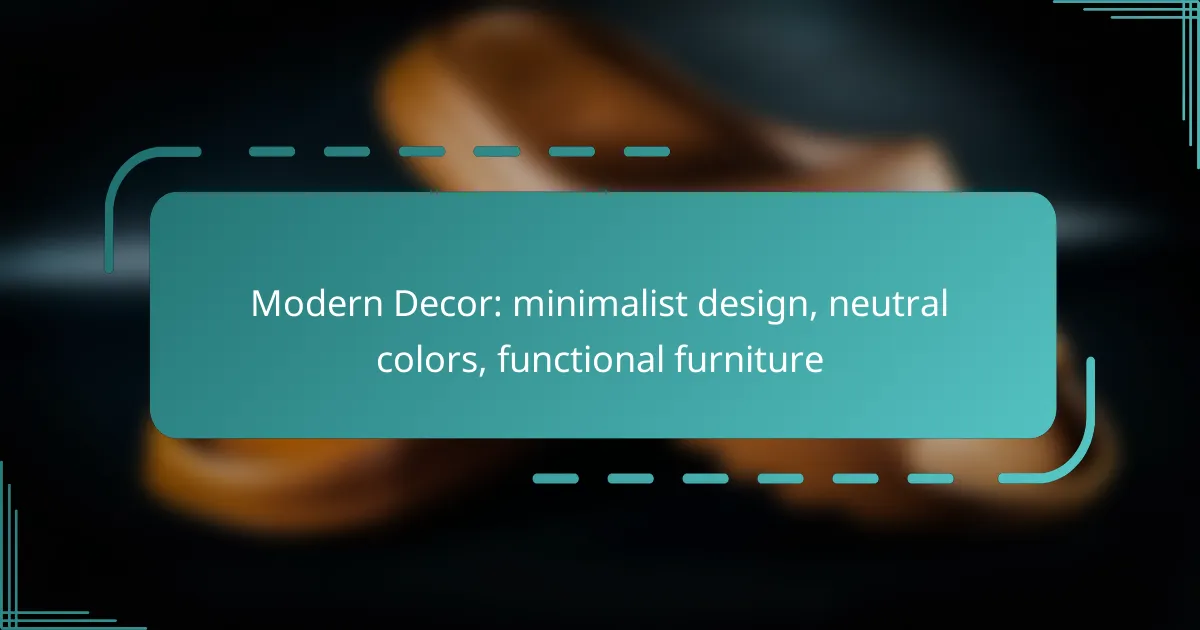Modern decor embraces minimalist design by prioritizing simplicity and functionality, creating open spaces that exude a clean aesthetic. Utilizing neutral colors enhances versatility and timelessness, allowing for a cohesive look that invites warmth and openness. Essential functional furniture, such as modular sofas and storage solutions, further supports this style by maximizing space while maintaining an elegant appearance.

How to achieve minimalist design in modern decor?
To achieve minimalist design in modern decor, focus on simplicity, functionality, and open spaces. This approach emphasizes a clean aesthetic with essential elements that enhance the overall environment without clutter.
Use open space effectively
Effective use of open space is crucial in minimalist design. Aim to create areas that feel airy and uncluttered, allowing for easy movement and a sense of tranquility. Consider leaving ample space between furniture pieces and avoiding overcrowding with decorative items.
To maximize open space, use furniture that is appropriately scaled for the room. For instance, a small sofa in a compact living area can help maintain an open feel, while larger pieces may overwhelm the space.
Incorporate multifunctional furniture
Multifunctional furniture is a key element in minimalist decor, as it serves multiple purposes while saving space. Look for items like ottomans that double as storage or coffee tables that can expand for dining. This approach not only reduces clutter but also enhances the room’s functionality.
When selecting multifunctional pieces, prioritize quality and durability. Investing in well-made furniture can provide long-term value and maintain the minimalist aesthetic over time.
Choose simple color palettes
A simple color palette is essential for achieving a minimalist look. Neutral tones such as whites, grays, and beiges create a calming backdrop that complements the minimalist ethos. These colors can make spaces feel larger and more cohesive.
To add depth, consider incorporating varying shades of the same color or subtle textures. For example, a mix of light gray and charcoal can add interest without overwhelming the simplicity of the design.

What are the benefits of neutral colors in decor?
Neutral colors in decor provide versatility and a timeless appeal, making spaces feel more open and inviting. They serve as a perfect backdrop for various design elements, allowing furniture and accessories to stand out while promoting a cohesive look.
Enhances natural light
Neutral colors reflect light effectively, which can make a room feel brighter and more spacious. Light shades such as whites, beiges, and soft grays can amplify the natural light coming from windows, reducing the need for artificial lighting during the day.
To maximize this benefit, consider painting walls in light neutral tones and using light-colored furnishings. Avoid dark colors that absorb light, as they can create a more enclosed and dim atmosphere.
Creates a calming atmosphere
Neutral colors are known for their soothing qualities, helping to create a tranquil environment. Shades like soft taupe or pale cream can reduce visual clutter and promote relaxation, making them ideal for bedrooms and living areas.
Incorporating neutral tones can also enhance the overall aesthetic of a space, allowing for easy integration of various textures and materials. To maintain a calming atmosphere, balance neutral colors with natural elements, such as wood or plants, which can add warmth and life to the decor.

Which functional furniture pieces are essential?
Essential functional furniture pieces for modern decor include items that maximize space while offering versatility and style. Key pieces such as modular sofas, storage ottomans, and wall-mounted shelves help create a minimalist environment that is both practical and aesthetically pleasing.
Modular sofas
Modular sofas are designed to adapt to various spaces and needs, making them a staple in minimalist design. These sofas consist of individual sections that can be rearranged or expanded, allowing for flexibility in layout and seating capacity.
When selecting a modular sofa, consider the size of your room and the number of users. Look for options with neutral colors that blend seamlessly with your decor, and ensure the materials are durable yet comfortable.
Storage ottomans
Storage ottomans serve a dual purpose, providing both seating and hidden storage. They are ideal for keeping small items organized while maintaining a clean look in your living space.
Choose storage ottomans that match your color scheme and are appropriately sized for your room. Consider those with removable tops for easy access and ensure they are sturdy enough to serve as additional seating when needed.
Wall-mounted shelves
Wall-mounted shelves are an excellent way to utilize vertical space in a minimalist home. They offer a stylish solution for displaying decor while keeping the floor area clear, which is essential for a spacious feel.
When installing wall-mounted shelves, select designs that complement your furniture and color palette. Ensure they are securely anchored to support the weight of items you plan to display, and consider varying the heights for visual interest.

How to select furniture for small spaces?
Selecting furniture for small spaces involves choosing pieces that maximize functionality while minimizing clutter. Focus on items that serve multiple purposes and fit comfortably within the available area.
Opt for space-saving designs
Space-saving designs are essential for small areas, as they allow for efficient use of limited square footage. Look for furniture that has a slim profile and can be easily integrated into your existing decor. Examples include narrow sofas, compact coffee tables, and wall-mounted shelves.
When selecting space-saving furniture, prioritize items that can be easily moved or rearranged. This flexibility can help you adapt your space for different activities, such as entertaining guests or creating a cozy reading nook.
Consider foldable options
Foldable furniture is a practical choice for small spaces, as it can be easily stored away when not in use. Consider foldable dining tables, chairs, and even desks that can be tucked away to free up space. These options are particularly useful in multi-functional rooms.
When choosing foldable items, ensure they are sturdy and easy to operate. Look for designs that blend seamlessly with your decor, so they remain visually appealing even when set up. Regularly assess your needs to determine which foldable pieces will best serve your lifestyle.

What are the trends in modern decor in the UK?
Modern decor trends in the UK emphasize minimalist design, neutral colors, and functional furniture. These elements create spaces that are not only aesthetically pleasing but also practical and comfortable for everyday living.
Biophilic design elements
Biophilic design incorporates natural elements into interior spaces, fostering a connection to nature. This can include the use of indoor plants, natural light, and materials like wood and stone. In the UK, popular choices for biophilic decor are large potted plants, green walls, and large windows that maximize daylight.
To effectively implement biophilic design, consider the layout of your space. Position plants near windows or in areas with good light exposure. Aim for a balance between natural and artificial elements to enhance the overall ambiance.
Smart home integration
Smart home integration is increasingly popular in modern UK decor, allowing homeowners to enhance functionality and convenience. This trend includes smart lighting, thermostats, and security systems that can be controlled remotely via smartphones or voice assistants.
When integrating smart technology, choose devices that complement your decor style. For instance, sleek, minimalist smart speakers or smart bulbs that can adjust color temperatures to match your neutral color palette can enhance the overall aesthetic. Ensure compatibility among devices to create a seamless smart home experience.

How to maintain a minimalist aesthetic?
Maintaining a minimalist aesthetic involves prioritizing simplicity and functionality in your space. Focus on reducing clutter, using neutral colors, and selecting furniture that serves multiple purposes.
Regular decluttering
Regular decluttering is essential for preserving a minimalist aesthetic. Set aside time weekly or monthly to assess your belongings and remove items that no longer serve a purpose or bring you joy.
Consider using the “one in, one out” rule: for every new item you bring into your home, remove an existing one. This practice helps keep your space organized and prevents accumulation.
When decluttering, categorize items into keep, donate, and discard piles. Aim to maintain a balance where only necessary items remain, ensuring your environment feels open and serene.
